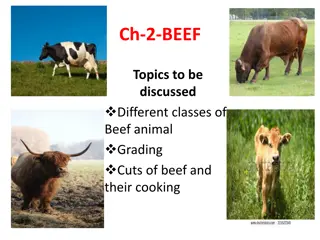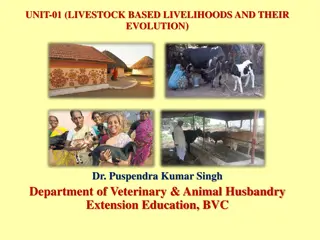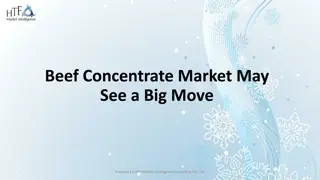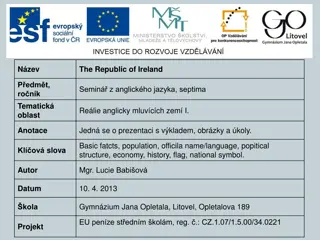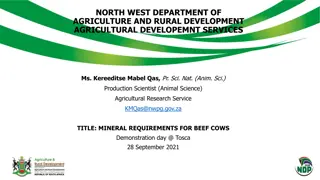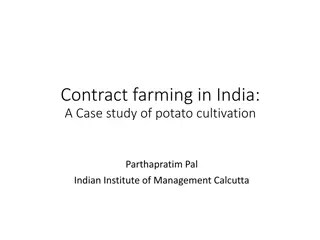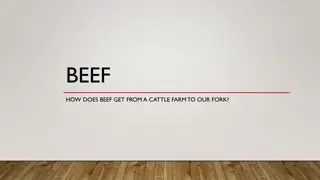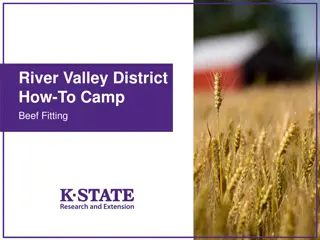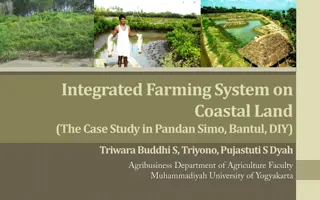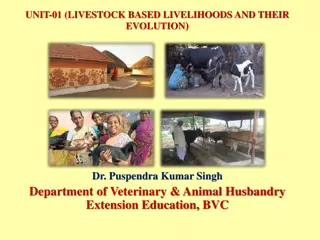Overview of Beef Farming in Ireland
The beef industry in Ireland plays a vital role in the country's agricultural economy, with millions of beef animals producing a significant amount of beef annually. However, despite its importance, beef farming has the lowest income per hectare compared to other farming types in Ireland. This overview discusses the beef and dairy breeds commonly found in Ireland, such as Charolais and Hereford, highlighting their characteristics and contributions to the industry.
Download Presentation

Please find below an Image/Link to download the presentation.
The content on the website is provided AS IS for your information and personal use only. It may not be sold, licensed, or shared on other websites without obtaining consent from the author.If you encounter any issues during the download, it is possible that the publisher has removed the file from their server.
You are allowed to download the files provided on this website for personal or commercial use, subject to the condition that they are used lawfully. All files are the property of their respective owners.
The content on the website is provided AS IS for your information and personal use only. It may not be sold, licensed, or shared on other websites without obtaining consent from the author.
E N D
Presentation Transcript
https://wordpress-606109- 2458856.cloudwaysapps.com/wp- content/uploads/2022/02/Grassland-Intro- for-IASTA.pptx Leaving Certificate Agricultural Science Beef Principles & Practices Produced for IASTA by Humphrey Jones, St. Columba s College
Introduction The beef industry in Ireland is the largest sector of the Irish Agricultural Economy There are 4.5 million beef animals in the country, producing 0.5 million tonnes of beef per year, of which 80% is exported. The main export countries are the UK, Germany, Egypt & Iran. In Irish farms, many beef animals originate from the dairy herd. These animals originate mainly from Munster and are relocated around the country. Beef farming, however, has the lowest income per hectare in Irish farms in comparison to other types of farming. It relies on the use of good spring grass and good silage.
Comparing Beef & Dairy Breeds Beef Breeds Beef Breeds Dairy Breeds Dairy Breeds Bottom line and Underline Parallel Shoulders & hindquarters wide and meaty Top Line and Underline converge at point. Shoulders narrow, hind- quarters narrow. Head short and wide Head long & narrow Back level and well fleshed Legs are long, wide and deep Back level but thin Legs are long, wide strong but not fleshy
Common Beef Breeds - Charolais Introduced to Ireland in the 1960 s due to the demand for continental style beef, this highly built, large muscled animal is now the most popular continental sire. They are usually white, but this is incompletely dominant and other variations do arise. They are frequently calving difficulties and a Charolais should not be served to any cow that has not had two calves at least. However, Charolais bulls in Artificial Insemination stations are known for easy calving.
Common Beef Breeds - Hereford The Hereford are a typical British breed, bred in Ireland for over 200 years. They are distinguished by their white heads, white stripe on the back of their necks and white underbelly, throat and legs (with a predominant brown / red body) As well as providing beef, the Hereford is useful as a sire. The Hereford, when crossed with the Friesian produces the Black White-head, a popular breed for the British market. There are two strains, a large frame and a small frame. The small frame is used for breeding with heifers, as this will make calving easier.
Common Beef Breeds Angus The Angus is smaller than Herefords and are considered the best example of a British breed. They have the typical barrelled shaped body, small head, short leg and highly developed hind quarters. They are black in colour and are hornless. These are dominant characteristics when crossed with other breeds. The meat quality is extremely good, but tend to be quite fat when young. This affects their selling quality in the continental market. Friesian heifers are often services with an Angus.
Common Beef Breeds Limousin This breed is increasing in popularity as a sire for dairy herds, as there is infrequent calving problems. The Limousin also is known as having an excellent carcase quality, and the ability to put on masses of lean meat quickly. The Limousin / Friesian offspring are ideal suckler dams. The red colour of the Limousin is recessive to black colours of Friesians so little red appears in the offspring of such a cross.
Common Beef Breeds - Simmental The Simmental is an example of a triple purpose animal (Beef, Dairy and Working) but is most noted in Ireland as a beef breed. It is often used in Europe as a dairy animal and has yields similar to that of the Friesian and milk quality is often better. The Simmental is a native of Switzerland, and may be yellow with white or red in colour, also with a dominant white head. Simmentals have a very high growing rate (over 10% more than Friesians, Hereford crosses or Angus crosses) Simmental bulls should never be used as sires for heifers.
Animal Growth & Development Growth Rates Two varying growth patterns Constantly fed at a high level of nutrition Over winter store animals The most common in Ireland are the store animals. These animals exhibit compensatory growth after each store period, which can be higher if fed constantly on a high plane of nutrition. This system keeps down winter feed costs and can be very profitable.
Growth Curve for Animals on a High Plane of Nutrition for Beef Production Weight Puberty Time
Growth Curve for Animals fed poorly over the Winer for Beef Production Weight Time
Animal Growth & Development - 2 Tissue Development and Composition The levels of body tissue vary throughout the cows life. The most significant development is the sharp increase in body fat after 2 years old. Therefore if the farmer notices excess fat in the abdominal area, he / she should not continue to feed the animal on such a high plane of nutrition. The time at which this fat deposition occurs varies amongst different breeds.
Animal Growth & Development - 3 Conformation Conformation refers to the shape of the animal, and particularly the distribution of muscle in the body. A good conformation refers to a lot of muscle in the areas that are worth the most. These areas are the hindquarters (round steak and roasting beef) and the back (Sirloin, rib - roasts and T-bone steaks) The type of breed determines the conformation of the animal in most cases.
Animal Growth & Development - 4 Conformation (Best to Worst) Continental breeds (Charolais etc.) British Breeds (Hereford etc) Dual Purpose (Friesian) Dairy Breeds (Jersey)
Grading Carcase Quality Carcase quality is assessed at slaughter and depends on two factors: Fatness & Conformation The price paid for the carcase depends on the grade obtained. Carcase is graded using the following: E (Best), U, R, O, P (Worst) Fatness is graded from 1 to 5, 1 being the leanest and 5 the fattiest.
Grading Carcase Quality - 2 E E U U R R O O P P 1 1 PA PB PC B 2 2 3 3 A 4L 4L 4H 4H 5 5
Grading Carcase Quality - 3 Most Irish Beef falls into the category of A. This is moderate quality beef that can be exported to less sensitive markets for a low price. Beef in category B is excellent quality and can be exported to markets like Germany and France. Use of continental breeds and early slaughtering can help improve the grade of the carcase.
Animal Growth & Development - 5 Influence of Sex Status on growth Bulls, castrated males (Steers and Bullocks) and heifers are the most common used in beef production in Ireland. Bulls have the fastest growth rates but can be violent. They may also try to serve cows and disrupt the farmers breeding plans. Steers do not produce testosterone, the male sex hormone, which inhibits their growth.
Animal Growth & Development - 6 Almost all males used in the Irish beef industry are castrated, as they are much tamer. Heifers have lower growth rates than bulls and steers. Weight at Slaughter: Bull 750Kg Steer 550Kg Heifer 450Kg
Beef Production Systems In Ireland, there are two main types of Beef Production, producing beef animals from the Dairy Herd (Calf to Beef) and producing beef animals from the Suckler Herd. Production from the Calf to Beef is more common in Ireland as Friesen calves are suitable for the continental market. Suckler herd animals account for 35 40% of the beef production in Ireland.
Beef Principles & Practice Beef from the Dairy Herd
Calf Rearing Calf rearing is the same for animals destined for the Beef market as those for Dairy (outlined at the end of the section). Nearly all Dairy farmers sell on their calves (those not needed as replacements heifers) to specialised farmers who finish off the animal. These calves are usually bought at the mart, and precautions must be taken when buying from a farmer you don t know. Care must also be taken when changing the calf onto their new diet after purchase.
Purchasing Calves Points to look for when purchasing calves at the mart: Conformation: Shoulders wide Wide Hind Quarters Deep Barrel Health: Eyes Bright and Clear (no discharge) Ears Pricked Up Nose Clear (no discharge) Naval clean, no swelling Anus should show no sign of scour. Generally lively and alert.
Care of Calves After Purchasing Care should be taken not to stress the calve during transport. Calves should only be fed water and glucose for the first 24 hours. This is done to clear the contents of the stomach. After 6 days the calve should be on full strength Milk Replacer. The calf will subsequently weaned onto Hay and Concentrates and later grass when available!
Days After Purchase Glucose (grams) Milk Replacer (grams) Water (litres) 100 - 2 1 2 AM 100 50 - 2 2 PM 70 3 AM 70 125 2 2 - PM 4 AM 125 200 2 2 - PM 5 AM 200 265 2 2 - PM 6 AM 265 265 2 2 - PM
Housing & Feeding Year 1 By November 1st of the first year, calves should weight 200Kg. They are now fully reared and are called WEANLINGS. Weanlings should be housed in open sheds bedded with straw or in slatted units. It is important that houses are very well ventilated but draught free. Silage is the most important winter feed and it should have a DMD of at least 73%. If the DMD is lower then concentrates should be provided. Live-weight gain (LWG) of 0.6kg for a Hereford Friesian Cross. By the end of winter, the calf should weight 280Kg.
Grazing Management of Yearlings Yearlings should be grazed on good grass during their second grazing season. They should be dosed for lice, stomach worms and hoose. In wet areas of land, dosing for Liver Fluke is advisable. Any disease will slow down the development of the animal. Yearlings should have a Live-weight Gain (LWG) of 0.8 Kg per day at this stage. When housed for the second year on Nov 1st, the yearling should weight 480kg.
Housing & Feeding Year 2 Housing is the same for the second year but the animal, being bigger, needs more floor space. Feeding is again silage but supplemented by concentrates to get a LWG of 1kg per day. This rate of growth will have a Hereford / Friesian cross at 550kg by February 1st, ready for slaughter. Final weight depends on breed.
Summary The principles of a successful beef production system are: Purchasing good quality calves Rearing them well. Feeding them well (with good grass, silage and meals) Controlling diseases. Maintaining target weights. The target weights for a Hereford Friesian crosses are shown on the next slide.
Target Weights LWG per day Target Weight Diseases to Prevent Date Age Diet Feb 1 0,0 40 kg 0.5 kg Milk Replacer, Hay, Meals, Rotational Grass Scour, Pneumonia, Lice, Worms May 1 0,3 90 kg 0.55 Yr 1 Nov 1 Good Silage, Meals 0,9 200 kg 0.6 Lice Mar 15 1,2 280 kg 0.8 Stomach Worms, Lungworms Nov 1 Rotational Grass, Silage, Meals 1,9 460 kg 0.9 Yr 2 Feb 1 2,0 550 kg 1.0
Beef Principles & Practice Beef from the Suckler Herd
Introduction There are approx 1.7 million suckler cows in Ireland. This kind of farming is low maintenance, yields low incomes and is often done on a part-time basis, where the farmer may have another job outside the farm. The suckler herd accounts for approx 35-40% of the beef produced in Ireland. Beef animals are not commercially milked and calves are allowed to suckle their mother, hence the name! Prices vary throughout the year, and producing beef off peak can get better prices, but overall costs are higher because of the use of concentrates.
Breeding Management Most suckler herds employ a spring calving system. This is to get the best use of summer grass. Most income comes from the sale of the calves so it is essential that each cow produce at least one reared calf per year. Reproductive efficiency refers to the number of calves weaned per 100 cows served. Good farms would have a Reproductive Efficiency of at least 90 100. The most important factor for achieving productivity is diet.
Breeding Management - 2 Animals should be in good condition, but not fat, before mating. They should have a condition score of 2.5 or greater (more to come on condition scoring) Calving interval also needs to be considered. It is best to have a calving interval of 12 months to get the most of the spring grass. Accurate heat detection is essential to ensuring the cows become pregnant. In large farms, where a bull is feasible, the bull is able to detect heat very efficiently.
Heat Detection & AI Cows will come into heat 3 8 weeks after calving and every 21 days after. The cow should be serviced by a bull or AI at each heat period or else essential time will be missed. Detecting heat can be quite difficult, so the herd should be observed at least four times daily Cows will attempt to mount other cows during this time so tail painting is a good method (Similar to raddling in sheep) Most servicing of cows is done by Artificial Insemination. As soon as the cow is detected as being in heat, the AI station should be informed
Suckling Period The Cows Diet In Suckler Herds, calves suckle their mother from birth (in Jan / Feb) until weaning in Oct / Nov. Feeding the cows is the most expensive part of the suckler herd. The cow s diet should in increased before mating (to improve condition scoring), for good milk production in early lactation and increased further in the suckling period. 4 5 months after calving the diet can be reduced and just fed for maintenance until the following year (just before mating) Good summer grass can provide all the cow s needs if managed correctly, otherwise concentrates need to be used.
Suckling Period The Calves' Diet The growth of the calve is influence more by milk intake in the first 4 5 months of it s life. After this, grazing becomes more important. (this is why the cow s diet reduces 4-5 months after calving). Creep feeding is important from July onwards during the first year. This allows the calves get access to the best grass but still be able to suckle their mother. Calves are weaned off their mother and housed in November. The target weights vary according to breed. Feed while housed is good silage supplemented by meals.
Target Weights at Weaning Weight at Weaning Breed / Cross Daily LWG Continental Breeds 1.5 kg 400 kg Continental / Friesian 1.25 340 kg Hereford / Friesen 0.8 0.9 280 kg
Management in Year 2 Management of weaned suckler calves for the remainder of their lives is similar to calves reared from the Dairy herd. It relies on winter feeding and housing, good grassland management in spring and summer, and prevention of disease. With proper management, the weight gains of calves reared on the suckler herd are maintained until slaughter. They also reach slaughter weight earlier. Weight at slaughter is 100 kg more than if reared artificially.
Diseases of Beef Animals Diseases of Beef animals include: Tuberculosis (TB) Stomach and Intestinal Worms. Lungworms Blackleg Grass Tetany Lice Red Water Fever
Diseases of Beef Animals - 2 Tuberculosis (TB) It affects all types of cattle, of all ages. Caused by Mycobacterium bovus Highly infectious Humans can also get this disease (A Zoonose) Symptoms Failure to Thrive Sweating Bad appearance







